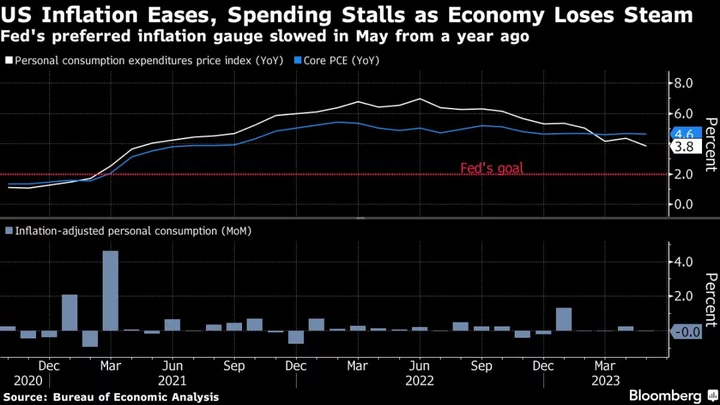US consumer spending — the economy’s main engine — has lost steam for most of this year, portending weaker growth ahead while also helping to cool inflation.
Inflation-adjusted spending was little changed in May and has essentially stalled since surging in the first month of 2023, according to Bureau of Economic Analysis figures published Friday. That may help to ease price pressures further after one of the Federal Reserve’s preferred inflation metrics fell last month to the lowest level in more than two years.
On the heels of data out Thursday that showed US gross domestic product was revised up notably in the first quarter, due in part to better-than-expected spending, Friday’s figures set the economy up for a substantial slowdown.
“We had already expected a slowing in second-quarter spending,” Wells Fargo & Co. economists Tim Quinlan and Shannon Seery said in a note to clients. “It now appears that we may need to cut our own forecast in half.”
Another potential obstacle came later Friday with the Supreme Court ruling that threw out President Joe Biden’s student-loan relief plan. While the decision to overturn the forgiveness program likely won’t have a major impact at the macroeconomic level by itself, it will add to the financial strain households are increasingly facing this year.
Read more: Without Student-Loan Relief, US Consumers Face Next Headwind
Weakness in consumer spending contrasts with recent data that have otherwise painted a picture of a resilient economy rather than one on the brink of recession. That’s been in large part due to the ongoing strength of the job market.
Solid advances in jobs and wages, which have bolstered the economy through over a year of interest-rate hikes, have been at the center of the Fed’s messaging that rates may need to go even higher to ultimately tame inflation. Even though Friday’s figures showed spending and inflation cooled, they still may not be enough to dissuade officials from more tightening, Rubeela Farooqi, chief US economist at High Frequency Economics, said in a note.
“For the Fed, a moderation in consumption will be welcome news, as will a deceleration in inflation,” Farooqi said. “However, these developments are not likely to change the very near-term path of policy, with policymakers committed to the view that rates need to rise further, to a more restrictive stance.”
The decrease in real spending on goods largely reflected a drop in purchases of motor vehicles, the report showed. Services spending increased on firmer outlays for international travel and transportation.
Consumers are also saving at one of the highest rates since early last year, which could signal additional caution going forward.
Inflation Easing
The personal consumption expenditures price index rose 0.1% in May, Commerce Department figures showed Friday. From a year ago, the measure eased to 3.8%, the slowest pace in more than two years.
Under the hood of the government report, a key price metric flagged by Fed Chair Jerome Powell showed a welcome slowdown. Services inflation excluding housing and energy services increased 0.2% in May from a month earlier, the smallest advance since July of last year, according to Bloomberg calculations. The figure was up 4.5% from a year ago.
Read More: Powell’s Favored Inflation Gauge for Services Hits 10-Month Low
Treasuries and the S&P 500 rallied after the report, though traders still expect the Fed to resume hiking interest rates at next month’s meeting, according to futures contracts.
What Bloomberg Economics Says...
“May’s personal income and outlays data show the relationship between income growth and inflation loosening incrementally. That makes us skeptical the Fed will need to hike rates by the full 50 basis points shown in the latest dot plot.”
— Stuart Paul, Eliza Winger and Jonathan Church
To read the full note, click here
While Friday’s numbers suggest that rates may not need to go as high as many Fed policymakers forecast, there’s still plenty of data between now and the central bank’s July meeting that could shape their thinking. The June jobs report, out next week, is expected to show still-strong hiring and low unemployment, and officials will also see updated readings on consumer and producer prices as well as retail sales in the coming weeks.
--With assistance from Kristy Scheuble.
(Updates with student loans impact to spending)

